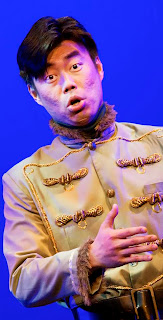Finney
Chapel
November
20
 |
| An opportunity to watch a virtuoso at work. |
Superstar
cellist Yo-Yo Ma titled his latest Silk Road Ensemble release A
Playlist Without Borders, reflecting the group’s international
makeup and focus. That would also have been an appropriate title for
his recital in Oberlin on Wednesday night, which covered a remarkable
musical and geographic range, from 19th-century European Romanticism
to modern Latin dance music. With longtime piano accompanist Kathryn
Stott providing driving rhythms and tasty embellishment, Ma held a
packed house spellbound.
Part
of the attraction was the chemistry between the two players, who have
been collaborating for nearly 30 years. They seem to communicate by
telepathy, rarely glancing at each other while nailing fancy breaks,
unusual timing and flashy finishes with razor-sharp precision. Their
duets have a strong organic feel, with emotional passages swelling in
tandem, or one instrument dropping back while the other articulates a
sensitive line or inventive phrasing.
And
they don’t need a single note of warm-up. From the opening bars of
Stravinsky’s Suite Italienne, their sound was perfectly
clean and well-defined, seamless in construction and elegant in
execution. Each of the five movements had a distinctly different
character, with Ma giving the music a lyrical quality – not a term
one typically uses to describe Stravinsky. Light and playful in the
duo’s spirited treatment, the suite made a lively, engaging opener.
Ma
dug into his 2003 Obrigado Brazil album for a medley of three
Latin songs, starting with Villa-Lobos’ “Alma Brasileira,”
which featured Stott on lead. He brought dark emotional hues to
Piazzolla’s “Oblivion,” then played Camargo Guarnieri’s
“Dansa Negra” as a dialogue with Stott, who set a snappy dance
floor pace with rolling barrelhouse rhythms.
The
mix of elements in de Falla’s Siete Canciones Populares
Españolas
(Seven Spanish Folk Songs) was rendered with exceptional clarity.
Stott set a tone of passionate intensity that Ma matched at times, or
played against with incredibly fine, delicate lines suggesting the
French impressionist influence. The rich array of moods and colors
they created culminated in a smart, swirling treatment of a flamenco
number, “Polo.”
Messiaen’s
Quatuor pour la fin du temps (Quartet for the End of Time), a
seminal work in the chamber repertoire, includes a movement for cello
and piano, “Louange à
l'Éternité
de Jésus” (In Praise of the
Eternity of Jesus). Ma was brilliant in bringing its earthly
anguish and spiritual yearning to life, holding long vibrato lines
with his head tilted back and eyes closed, like a man in a trance.
Which he apparently was. After drawing the piece to a whisper finish,
he sat silent for almost a minute. Some musicians let the final notes
reverberate and fade away for dramatic effect. But in this case it
seemed Ma couldn’t move until his spirit returned from a
faraway place to reinhabit his body.
After
all those exotic excursions, it felt almost mundane to return to
the mainstream canon for the closing work, Brahms’ Sonata No. 3.
Ma and Stott gave it a brisk, animated reading, pumping some fresh
energy into a staid classic. Ma showed masterful control of his
instrument, particularly in a piece that was written for violin and
piano. Playing the string part on cello is difficult enough; making
it look easy is the work of a virtuoso.
Yo-Yo
Ma makes everything he touches look easy, one of the reasons he
occupies such a prominent and respected niche in the classical music
world. Another is his open-heartedness and unfailing generosity. He
came back for three encores after this performance – Elgar’s
sweet Salut D’Amour, “Cristal” from the Obrigado
Brazil album, and Saint-Saëns’
The Swan, a sure crowd-pleaser. Audiences in Oberlin like to
show their approval with their feet as well as their hands, so there
was plenty of stamping accompanying the final rounds of applause.
This
was the third time Ma performed in northeast Ohio over the past year,
though the first in a chamber setting that gave the audience a
close-up opportunity to watch him work. He throws himself completely
into the music, playing every piece with a brilliant combination of
technical finesse and double expression –the feeling he puts into
the music, and the emotions on his face. At one point during the
Oberlin recital, he looked ready to burst into tears.
That
kind of naked emotional honesty establishes a powerful bond with the
audience, and makes Ma’s departing smiles and goodbye waves seem
real rather than forced. No one – not even the elderly gentleman
sitting next to this critic who fell asleep – leaves his concerts
unhappy.
For
more on Yo-Yo Ma: http://www.yo-yoma.com/
For
more on Kathryn Stott: http://www.kathrynstott.com/
Photo: Roger Mastroianni











